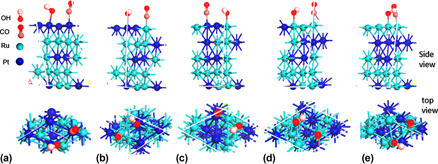Crossref Citations
This article has been cited by the following publications. This list is generated based on data provided by
Crossref.
Alam, Md. Khorshed
Saito, Shuhei
and
Takaba, Hiromitsu
2017.
Modeling of equilibrium conformation of Pt2Ru3 nanoparticles using the density functional theory and Monte Carlo simulations.
Journal of Materials Research,
Vol. 32,
Issue. 8,
p.
1573.
Alam, Md Khorshed
and
Takaba, Hiromitsu
2018.
Equilibrium atomic conformation of Pt2Ru3 nanoparticles under gas atmosphere of CO/H2 investigated by density functional theory and Monte Carlo simulation.
MRS Communications,
Vol. 8,
Issue. 2,
p.
562.
Wang, Wei
Jing, Wangli
Liu, Yanqin
Wang, Yahui
Zhao, Jiao
and
Lei, Ziqiang
2018.
Supporting Pd nanoparticles on riboflavin-derived carbon: an efficient electrocatalyst for ethylene glycol oxidation.
Ionics,
Vol. 24,
Issue. 6,
p.
1745.
Zhao, Ming
Yang, Xuan
Hood, Zachary D.
Chi, Miaofang
and
Xia, Younan
2018.
Facile synthesis of Pt–Ag octahedral and tetrahedral nanocrystals with enhanced activity and durability toward methanol oxidation.
Journal of Materials Research,
Vol. 33,
Issue. 23,
p.
3891.
Shen, Tao
Lu, Yun
Gong, Mingxing
Zhao, Tonghui
Hu, Yezhou
and
Wang, Deli
2020.
Optimizing Formic Acid Electro-oxidation Performance by Restricting the Continuous Pd Sites in Pd–Sn Nanocatalysts.
ACS Sustainable Chemistry & Engineering,
Vol. 8,
Issue. 32,
p.
12239.
Campos-Roldán, C.A.
and
Alonso-Vante, N.
2021.
Understanding the oxophilic effect on the hydrogen electrode reaction through PtM nanostructures.
Journal of Solid State Electrochemistry,
Vol. 25,
Issue. 1,
p.
187.
Alam, Md. Khorshed
Saito, Shuhei
Hirosawa, Fumiya
Miyagawa, Masaya
and
Takaba, Hiromitsu
2022.
Conformational effect of Pt2Ru3 nanoparticle on surface coverage of CO/H2 by materials informatics-integrated computational method.
MRS Communications,
Vol. 13,
Issue. 1,
p.
27.
Music, Denis
Mariș, Andrei-Ioan
Khayyamifar, Sana
Sadowski, Grzegorz
and
Ruzgas, Tautgirdas
2024.
Reaction of hydrogen peroxide with amorphous Ti–O surfaces.
Results in Surfaces and Interfaces,
Vol. 16,
Issue. ,
p.
100252.
